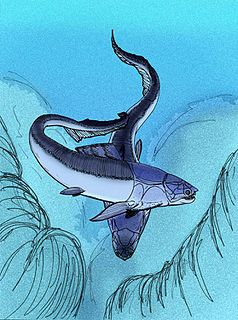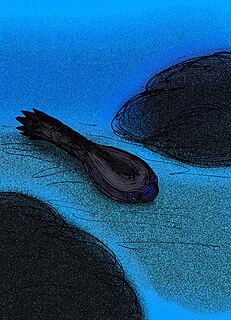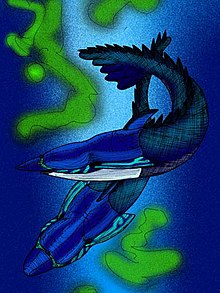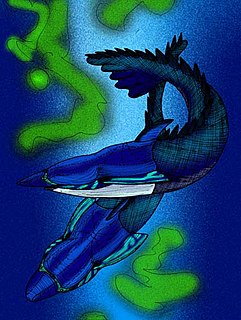
Protaspididae is an extinct family of pteraspidid heterostracan agnathans. Fossils of the various genera are found in early Devonian-aged marine strata. Protaspidids were once thought to represent a transitional form between the Pteraspididae and the Psammosteida, bearing the broad head shield shape of the latter, due to a more benthic (bottom-dwelling) existence, but recent phylogenical comparisons demonstrate that the protaspidids are actually highly derived pteraspidids, and that the anchipteraspidids, the most primitive of pteraspidids, are the sister-group of the Psammosteids.

Galeaspida is an extinct taxon of jawless marine and freshwater fish. The name is derived from galea, the Latin word for helmet, and refers to their massive bone shield on the head. Galeaspida lived in shallow, fresh water and marine environments during the Silurian and Devonian times in what is now Southern China, Tibet and Vietnam. Superficially, their morphology appears more similar to that of Heterostraci than Osteostraci, there being currently no evidence that the galeaspids had paired fins. However, Galeaspida are in fact regarded as being more closely related to Osteostraci, based on the closer similarity of the morphology of the braincase.

Diamantinasaurus is an extinct genus of non-lithostrotian titanosaurian sauropod from Australia that lived during the early Late Cretaceous, about 94 million years ago. The type species of the genus is D. matildae, first described and named in 2009 by Scott Hocknull and colleagues. Meaning "Diamantina lizard", the name is derived from the location of the nearby Diamantina River and the Greek word sauros, "lizard". The specific epithet is from the Australian song Waltzing Matilda, also the locality of the holotype and paratype. The known skeleton includes most of the forelimb, shoulder girdle, pelvis, hindlimb and ribs of the holotype, and one shoulder bone, a radius and some vertebrae of the paratype.
Podolaspis is an extinct genus of pteraspidid heterostracan agnathan which existed during the early Devonian period. It was originally described by Zych in 1931, and contains the species P. lerichei, and P. danieli.
Lechriaspis is an extinct genus of poraspid heterostracan agnathan known from the Early Devonian of northern Utah, western United States.
Poraspis is an extinct genus of heterostracan. Fossils are found in Late Silurian and Early Devonian marine strata of Norway, Canada and the United States.
Ariaspis is an extinct genus of cyathaspidiform heterostracan agnathan. Fossils are found in marine strata of Canada and Europe from the late Silurian period until its extinction during the Early Devonian. A new species, A. arctata, was described by David K. Elliott and Sandra Swift in 2010.

Xiangshuiosteus wui is a brachythoracid arthrodire placoderm from the Late Emsian epoch of Wuding, Yunnan. It has recently been reassessed as a dunkleosteid.
The Lost Burro Formation is a Middle to Upper/Late Devonian geologic formation in the Mojave Desert of California, in the Western United States.
The Hidden Valley Dolomite is a Silurian−Devonian geologic formation in the northern Mojave Desert of California, in the western United States.

Psammmosteida also called as Psammosteoidei is a suborder of pteraspidid heterostracan agnathans. The psammosteids had broad, flattened bodies, suggesting a predominantly benthic habit. The earliest unequivocal psammosteid is Drepanaspis of Early Devonian Germany, which is either included in the family Psammosteidae, or placed within its own family, Drepanaspididae. If the late Silurian/Early Devonian Weigeltaspis is a psammosteid, as opposed to being a traquairaspid, then that genus, instead, would be the oldest psammosteid. However, its placement within Heterostraci remains a matter of debate. Other notable psammosteids include Psammosteus, and Obruchevia, two genera of enormous species with dorsal shields around one meter in diameter. The Psammosteids were the only heterostracans to survive to the end of the Devonian, where they finally perish during the Hangenberg event.

Cyathaspidiformes is an extinct order of heterostracan vertebrates known from extensive fossil remains primarily from Silurian to Early Devonian strata of Europe, and North America, and from Early Devonian marine strata of Siberia.

Blieckaspis priscillae is a pteraspidid heterostracan agnathan from the Middle Devonian of North America.

Amphiaspidida is a taxon of extinct cyathaspidid heterostracan agnathans whose fossils are restricted to Lower Devonian marine strata of Siberia near the Taimyr Peninsula. Some authorities treat it as a suborder of Cyathaspidiformes, while others treat it as an order in its own right as "Amphiaspidiformes." In life, they are thought to be benthic animals that lived most of their lives mostly buried in the sediment of a series of hypersaline lagoons. Amphiaspids are easily distinguished from other heterostracans in that all of the plates of the cephalothorax armor are fused into a single, muff-like unit, so that the forebody of the living animal would have looked like a potpie or a hot waterbottle with a pair of small, or degenerated eyes sometimes flanked by preorbital openings, a pair of branchial openings for exhaling, and a simple, slit-like, or tube-like mouth.

Traquairaspidiformes is an order of extinct heterostracan agnathan fish known from the Silurian and Early Devonian periods. It is predominantly known from Late Silurian fluvial deposits from Wales and England: some species were also found in shallow water marine environment in Canada and North America.

Protopteraspididae is an extinct family of pteraspidid heterostracan agnathans. Fossils of the various genera are found in early Devonian-aged marine strata. Protopteraspidids were once thought to represent a taxon of basal pteraspidids but recent evaluations demonstrate that Protopteraspididae is a paraphyletic group of various transitional forms representing a gradual transition between the more advanced Pteraspoidei, and the anchipteraspidids and the Psammosteids.

Lamiaspis longiripa is an extinct pteraspid heterostracan agnathan vertebrate found in marine strata of Early Devonian Nevada.
Anchipteraspididae is an extinct family of heterostracan vertebrates restricted to Late Silurian and Early Devonian strata of Arctic Canada.














